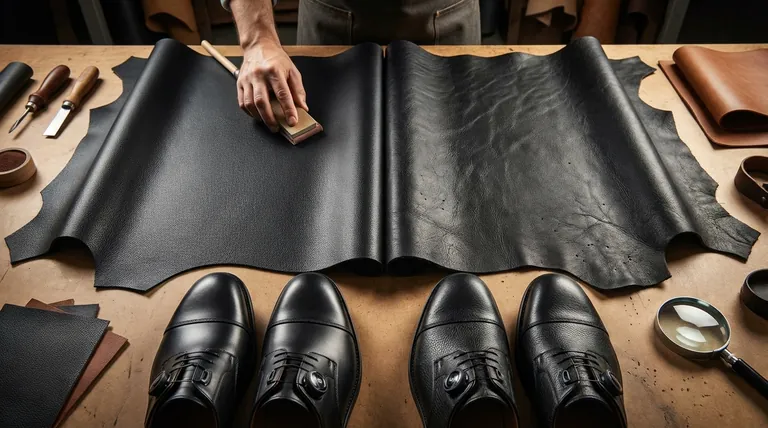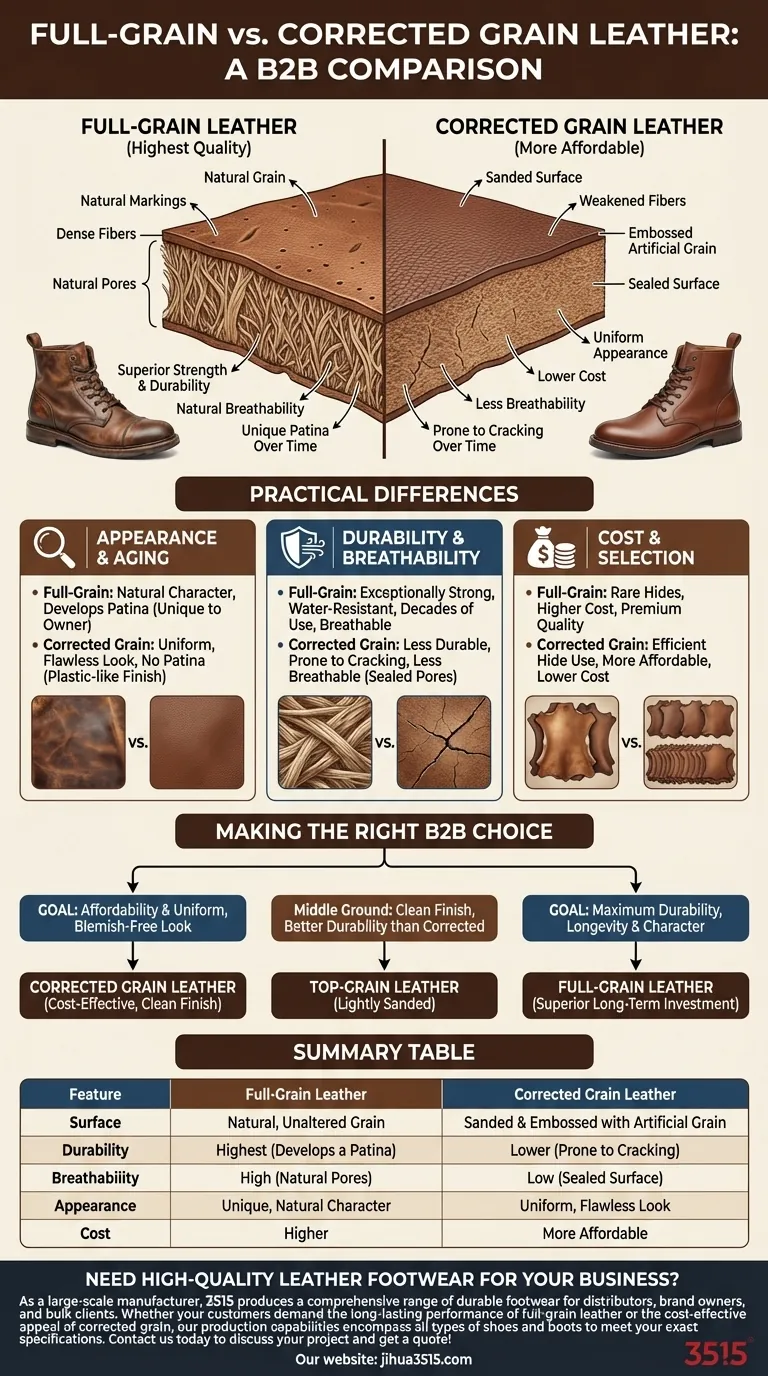At its core, corrected grain leather is leather that has been sanded and buffed to remove imperfections like scars or blemishes from the hide's surface. An artificial grain pattern is then embossed onto it to create a uniform, flawless appearance. This process makes it distinct from full-grain leather, which is left in its natural, unaltered state.
The fundamental difference lies in a trade-off: corrected grain leather offers a uniform look and lower cost by sacrificing the superior strength, breathability, and unique aging potential of full-grain leather.

The Anatomy of Leather: Full-Grain vs. Corrected Grain
To understand the comparison, you must first understand how each type is made and what part of the hide it comes from.
What is Full-Grain Leather?
Full-grain leather is the highest quality grade. It comes from the very top layer of the hide and includes all of the natural grain.
The surface is not sanded or buffed, so it retains the hide's original texture and markings. This natural surface is incredibly dense and durable.
Because of this, full-grain leather is the strongest and most long-lasting type available. Its natural pores also allow it to breathe, making it more comfortable over time.
What is Corrected Grain Leather?
Corrected grain also starts as top-layer leather, but it's made from hides that have significant imperfections.
To create a usable product, the surface is mechanically sanded to remove these blemishes.
After sanding, an artificial grain pattern is stamped onto the surface, and it is often finished with sealants. This process creates a very consistent and uniform look.
The Practical Differences: Appearance, Durability, and Cost
The manufacturing process for each leather type results in significant differences in how they perform and look over their lifespan.
Appearance and Aging
Corrected grain leather has a smooth, consistent, and often semi-glossy finish. It looks uniform from day one but does not change much over time and will not develop a rich patina.
Full-grain leather showcases the hide's natural character, including minor scars or wrinkles. Over time, it absorbs oils and develops a beautiful, sought-after patina that is unique to the owner.
Durability and Breathability
The dense, tightly-packed fibers of full-grain leather make it exceptionally strong, water-resistant, and durable. It holds up to heavy use for decades.
The sanding process used to create corrected grain leather removes the strongest fibers from the hide's surface. This weakens the leather and makes it less durable than full-grain. The artificial coating also seals the pores, reducing breathability.
Cost and Material Selection
Full-grain leather requires near-perfect hides, which are rare. This scarcity, combined with its superior quality, makes it the most expensive type of leather.
Corrected grain allows tanneries to use hides that would otherwise be discarded. This efficient use of raw materials makes it a significantly more affordable option.
Understanding the Trade-offs
Choosing between these leather types involves accepting a clear set of compromises. Being aware of them is key to avoiding disappointment.
The Illusion of Perfection
The primary appeal of corrected grain is its flawless, uniform appearance. However, this perfection comes at the cost of the natural character that many people value in leather goods.
The artificial grain can sometimes look less authentic, and the finish can appear more plastic-like compared to the rich, organic texture of full-grain.
The Sacrifice in Longevity
While more affordable, corrected grain products will not last as long as their full-grain counterparts. The compromised fiber structure is more prone to cracking and will not wear as gracefully.
The Break-in Period
Full-grain leather is often stiff when new and requires a break-in period to become supple and mold to the user.
Corrected grain is typically thinner and more pliable out of the box. However, it will never conform to the wearer in the same way that full-grain leather does.
Making the Right Choice for Your Goal
Your final decision should be guided by your priorities, whether they are budget, appearance, or long-term performance.
- If your primary focus is affordability and a uniform, blemish-free appearance: Corrected grain leather provides a clean look at a much lower price point.
- If your primary focus is maximum durability, longevity, and developing character over time: Full-grain leather is the superior choice and a worthwhile long-term investment.
- If you seek a middle ground with a clean finish but better durability than corrected grain: Look into top-grain leather, which is only lightly sanded to maintain more of its original strength.
Ultimately, choosing the right leather means deciding whether you value manufactured perfection or natural performance.
Summary Table:
| Feature | Full-Grain Leather | Corrected Grain Leather |
|---|---|---|
| Surface | Natural, unaltered grain | Sanded and embossed with artificial grain |
| Durability | Highest (develops a patina) | Lower (prone to cracking) |
| Breathability | High (natural pores) | Low (sealed surface) |
| Appearance | Unique, natural character | Uniform, flawless look |
| Cost | Higher | More affordable |
Need High-Quality Leather Footwear for Your Business?
As a large-scale manufacturer, 3515 produces a comprehensive range of durable footwear for distributors, brand owners, and bulk clients. Whether your customers demand the long-lasting performance of full-grain leather or the cost-effective appeal of corrected grain, our production capabilities encompass all types of shoes and boots to meet your exact specifications.
Contact us today to discuss your project and get a quote!
Visual Guide

Related Products
- Wholesale Comfort Leather Business Shoes with Dial Lacing System
- Durable Leather Work Boots for Wholesale & Custom Manufacturing
- Durable Leather Work Boots for Wholesale & Custom OEM Manufacturing
- Durable Leather Tactical Boots Wholesale & Custom Manufacturing for Brands
- Wholesale Leather Work Boots with Customizable Wedge Sole for Brands
People Also Ask
- What are the key features of high-quality leather in shoes? Invest in Durability and a Perfect Fit
- What are the benefits of seamless leather in office work shoes? Eliminate Friction for All-Day Comfort
- How does top-grain leather differ from full-grain? Choose the Right Leather for Your Products
- What are the environmental benefits of choosing real leather shoes? Durability and Waste Reduction
- How can crocodile-inspired leather dress shoes make a statement at formal events? Command Attention with Bold Style



















